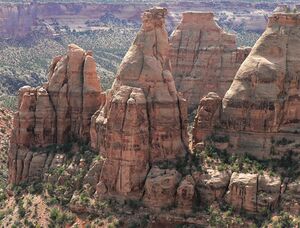Pipe Organ (Colorado National Monument)
Topic: Earth
 From HandWiki - Reading time: 3 min
From HandWiki - Reading time: 3 min
| Pipe Organ | |
|---|---|
 Northwest aspect | |
| Highest point | |
| Elevation | 5,731 ft (1,747 m) [1] |
| Prominence | 241 ft (73 m) [1] |
| Parent peak | Independence Monument[1] |
| Isolation | 0.28 mi (0.45 km) [1] |
| Coordinates | [ ⚑ ] : 39°05′56″N 108°43′34″W / 39.0988704°N 108.7262103°W [2] |
| Geography | |
Lua error in Module:Location_map at line 522: Unable to find the specified location map definition: "Module:Location map/data/Colorado" does not exist.
| |
| Location | Colorado National Monument Mesa County, Colorado, U.S. |
| Parent range | Colorado Plateau Uncompahgre Plateau |
| Topo map | USGS Colorado National Monument |
| Geology | |
| Age of rock | Late Triassic to Early Jurassic[3] |
| Type of rock | Wingate Sandstone |
| Climbing | |
| First ascent | January 31, 1961 |
| Easiest route | class 5.10 C1 climbing[1] |
Pipe Organ is a 5,731-foot-elevation (1,747-meter) sandstone pillar located in Colorado National Monument, in Mesa County of western Colorado, United States.[2] This 400+ foot tower is situated in Wedding Canyon, less than one-half mile east of the monument's visitor center, and 9 miles (14 km) west of the community of Grand Junction. It is also immediately northwest of another popular climbing destination, Independence Monument, and both can be seen from viewpoints along Rim Rock Drive. The first ascent of the summit was made January 31, 1961, by John Auld, Gary Ziegler, Jim Dyson, and John Kuglin.[4][5] Pipe Organ has a subsidiary summit unofficially named Organ Pipe Spire on the east aspect,[6] which the National Park Service refers to as Praying Hands.[7] This 325-foot-high subsidiary peak was originally named Squall Spire in 1976 by Harvey T. Carter of the first ascent party.[8]
Geology
This tower is the remnant of a differentially eroded fin composed primarily of cliff-forming Wingate Sandstone, which consists of wind-borne, cross-bedded quartzose sandstones deposited as ancient sand dunes approximately 200 million years ago in the Late Triassic. The thin caprock at the summit consists of fluvial sandstones of the resistant Kayenta Formation. The slope around the base of Pipe Organ is Chinle Formation.[9] The floor of the canyon is Precambrian basement rock consisting of gneiss, schist, and granites. Precipitation runoff from this geographical feature drains to the Colorado River, approximately two miles to the northeast.
Climate
According to the Köppen climate classification system, Pipe Organ is located in a semi-arid climate zone.[10] Summers are hot and dry, while winters are cold with some snow. Temperatures reach 100 °F (38 °C) on 5.3 days, 90 °F (32 °C) on 57 days, and remain at or below freezing on 13 days annually. The months April through October offer the most favorable weather to visit.
Gallery
Climbing
Established rock climbing routes on Pipe Organ and Organ Pipe Spire:[11]
- Southeast – class 5.10 C1 – 3 pitches – First Ascent 1961
- Southwest Face – class 5.10+ C2 – 3 pitches
- Organ Pipe Spire – class 5.8+ – 2 pitches
- Sirocco – class 5.9 – FA 1976
- Pipe Dream – class 5.11+ – 5 pitches – FA 2005
- Aces & Eights – class 5.12 C2 – 4 pitches
- Ender's Game – class 5.10 – 3 pitches
- The Weird Fun – class 5.10 – 3 pitches
See also
- List of rock formations in the United States
- Kissing Couple
- Sentinel Spire
References
- ↑ 1.0 1.1 1.2 1.3 1.4 "Pipe Organ - 5,731' CO". https://listsofjohn.com/peak/6573.
- ↑ 2.0 2.1 "Pipe Organ". United States Geological Survey. https://geonames.usgs.gov/apex/f?p=gnispq:3:::NO::P3_FID:174540.
- ↑ Fruita, Mailing Address: 1750 Rim Rock Drive; Us, CO 81521 Phone: 970 858-2800 Contact. "Geologic Formations - Colorado National Monument (U.S. National Park Service)". https://www.nps.gov/colm/learn/nature/geologic-formations.htm. Retrieved 24 April 2023.
- ↑ Jeff Achey, 2002, Climb! The History of Rock Climbing in Colorado, The Mountaineers Books, page 123.
- ↑ "First Ascent Timeline". https://www.deserttowersbook.com/first-ascent-timeline. Retrieved 24 April 2023.
- ↑ "Organ Pipe Spire - 5,710' CO". https://listsofjohn.com/peak/171165.
- ↑ "Canyon rim and window rock trail". https://www.nps.gov/colm/planyourvisit/upload/Canyon%20Rim%20and%20Window%20Rock%20Trail.pdf.
- ↑ Stewart M. Green, 2019, Rock Climbing Colorado A Guide to More Than 1,800 Routes, 3rd Edition, Falcon Guides, ISBN:9781493037353, page 444.
- ↑ Stanley William Lohman, The Geologic Story of Colorado National Monument, Geological Survey Bulletin 1508, pages 28-30.
- ↑ Peel, M. C.; Finlayson, B. L.; McMahon, T. A. (2007). "Updated world map of the Köppen−Geiger climate classification". Hydrol. Earth Syst. Sci. 11 (5): 1633. doi:10.5194/hess-11-1633-2007. ISSN 1027-5606. Bibcode: 2007HESS...11.1633P.
- ↑ "Rock Climbing in Organ Pipe Spire and Pipe Organ Spire, Grand Junction Area". https://www.mountainproject.com/area/113626593/organ-pipe-spire-and-pipe-organ-spire. Retrieved 24 April 2023.
External links
- Weather forecast: National Weather Service
- Pipe Organ rock climbing: Mountainproject.com
- Pipe Organ photo: USGS
 |
 KSF
KSF




